
Rights Reserved - Free Access.
This digital object is protected by copyright and/or related rights. This digital object is accessible without charge, but its use is subject to written permission.
Unless expressly stated otherwise in the licensing conditions, you are free to make any of the acts permitted by your national copyright and related rights act, including browsing, printing and making a copy for your own personal purposes.
All other acts of reproduction and communication to the public are subject to the licensing conditions attached to the digital object.
ARMY BOOTS OF THE WORLD. REVIEWS
Important notice: we do not sell any boots! The prices are given for information purposes only!
Poland ![]()
Military Boots of Poland ("Opinacze")
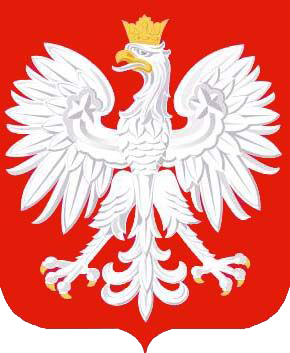
The armed forces of the Republic of Poland (Siły Zbrojne Rzeczypospolitej Polskiej) consists of four main components: the Army (Wojska Ląadowe or WL), Air Force (Wojska Lotnicze), Navy (Marynarka Wojenna) and Special Forces (Wojska Specjalne).
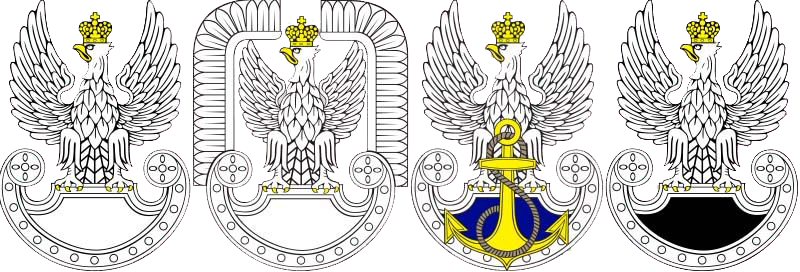
The common name for the Polish military boots is "Opinacze", this term was used from the times of the Polish People's Republic to the second half of the 1990s. Originally, the term referred exclusively to the army boots featuring leather cuffs (stitched to the top of the boots) with two buckles fasteners on each. These boots are usually from 10 to 12 centimetres in height, and they are very similar to the American M-43 boots and the French "Rangers".
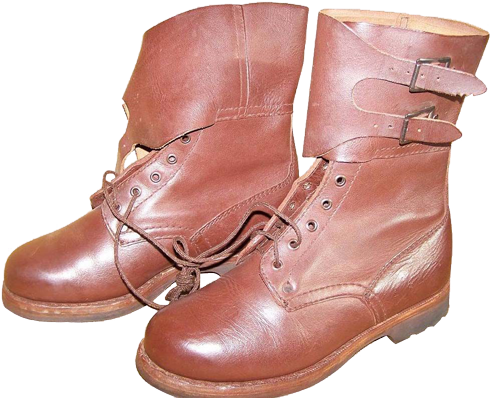

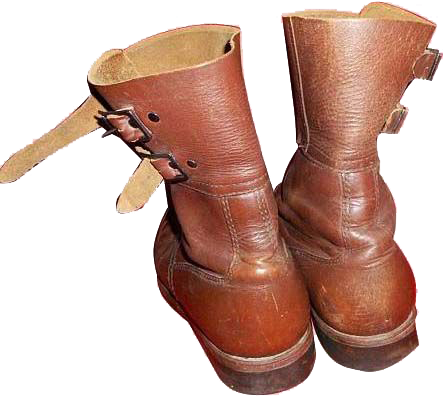
The very name "opinacze" ("opinacz" in the singular) means a strip of leather (with two buckles) designed to give an extra height to the boots - in other words it can be translated as "leggings" or "gaiters". This name appeared in Poland in the period between the First and the Second World Wars, when the Polish infantry wore low boots with textile gaiters which were attached to the boots by means of belts and a fixed lower edges of pants, actually being the leggings.
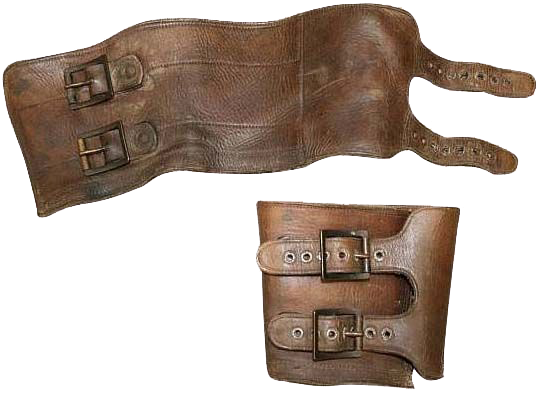
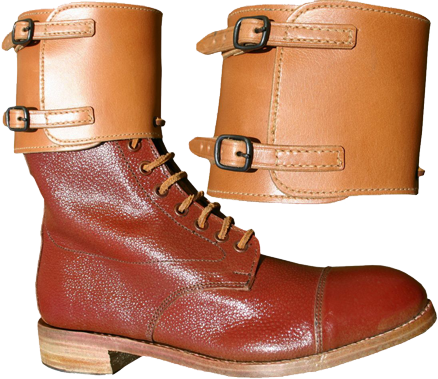
As the Poles themselves used to tell about this design: "... wsuwało sie dól spodni i je nim na wystających z trzewików onucach... opinało". This is the origin of the term. In 1958, taking into account the American and French experience a more rational solution appeared - military boots with sewn-on leather cuffs.
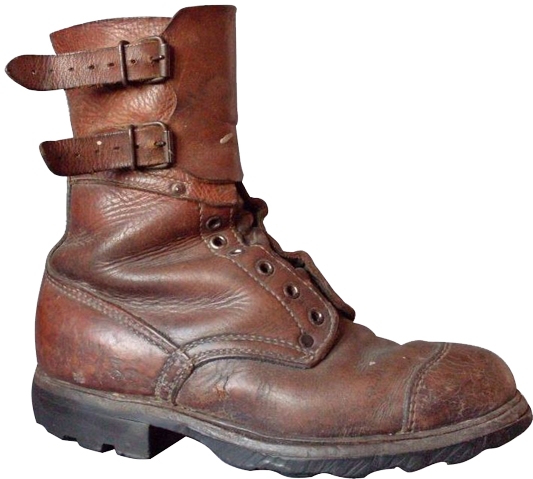

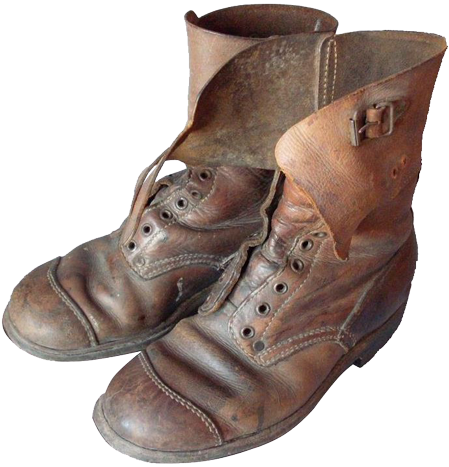
For many years different types and colours of leather was used for these boots. The very first sample boots of the year 1958 featured reinforced toe caps (an additional layer of leather), and rubber tread pattern of the out-sole was similar to the French sample.

Further on, since the beginning of the 1960s, they began using the out-sole with tread pattern of the Polish design. At the same time they got rid of additional leather layer on the toe caps. The two main colours of the Polish military boots (black and brown) can vary in shades, in colour of the inner leather lining (more or less light or dark), and by the details of the manufacturer's marking on the out-soles.
The colour of the Polish military boots served as an additional identifier of a certain soldier belonging to a branch of the Polish Armed Forces: brown "opinacze" were issued to the army troops (ground troops and paratroopers, infantry and tank crews), while the black boots were provided to the Air Force and Air Defence Forces, to the Navy and the Marines.
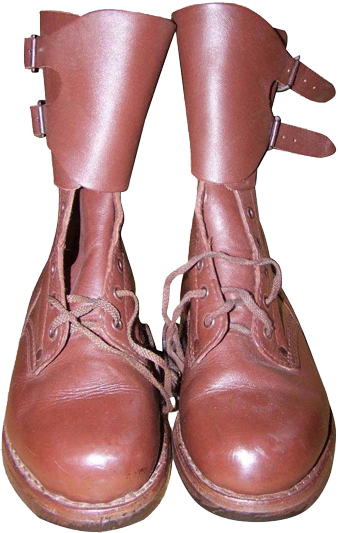
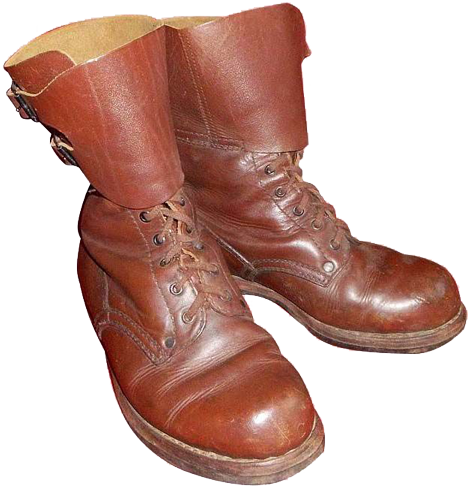
Regardless of the colour of boots, they are distinguished by the carefully made leather with a hydrophobic impregnation, which was much more soft and comfortable compared with the French military boots "Rangers"; the lacing system consisted of five pairs of simple round eyelets, leather cuffs with two buckles on each were stitched to the top of the boots.
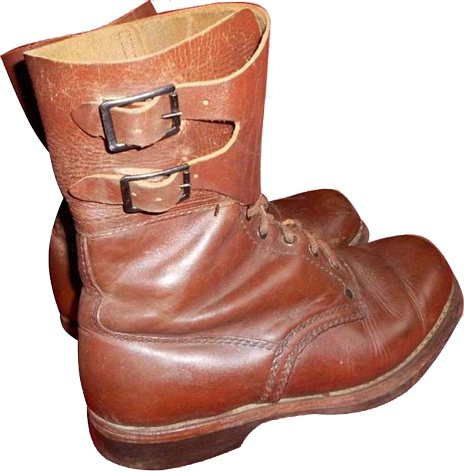

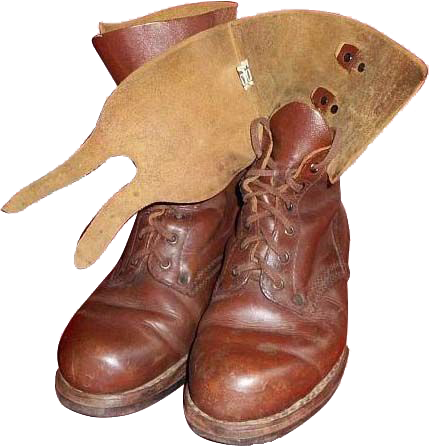
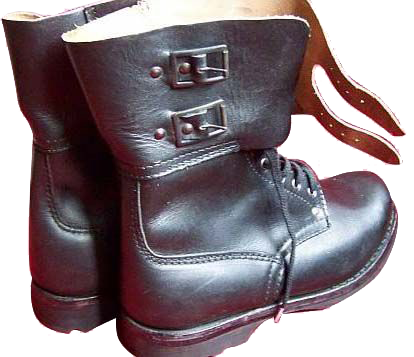
The boots design was reinforced by a pair of rivets at the bottom of the lacing system. These boots are glued and stitched by "Goodyear welt construction", solid rubber out-sole, often reinforced with boot nails.
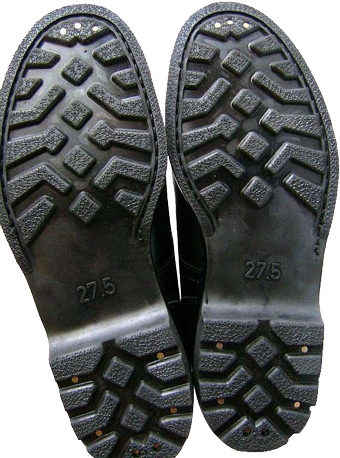
The Polish army boots of "opinacze" type were produced both with the conventional rubber out-soles and with oil and gasoline-resistant out-soles (the last was intended specially for the personnel of tank and motorized troops). There was also a version of such specialized boots for special forces, they differed with the forms of buckles on boots, they also were characterized by an increased height and improved overall design.
However, there were no separate military boots for the officers and the soldiers of the Polish Armed Forces.
"Opinacze" of this types had no leather lining inside the boots, except for the lower part of the boot up to the level of the malleolus bones of the feet. These boots are quite comfortable in terms of wear, they also provide good fixation of the ankle and protection from potential injuries and sprains.


As it was mentioned earlier, the design of the leather cuffs and the buckles of the Polish military boots are very similar to the French BMJA Mle 52 boots (model of the 1952), but the leather of the boot's top is much more "friendly" to the soldiers' feet. The Poles used the out-soles tread pattern of their own design, in particular, one should mention "Salute"- type tread pattern.

Just as in the French boots the boots tongues of the Polish "opinacze" are sewn together from two parts, and the resulting seam is located the middle and along the height of the tongue.
In the very first models of "opinacze" the cuff was not leather, but made of canvas. Similarly to the USSR, the "socialist" Poland had the problems with the provision of a wide variety of goods, including specialized footwear. So the Polish military boots were very popular among the civilians as well and these boots were widely used for hiking, fishing, and as casual footwear, like hunting and winter boots. This popularity was caused by good workmanship and reliability of the "opinacze".
On the specialized Polish web-forums there are many opinions, that the brown and black "opinacze" were the best boots the Polish Armed Forces ever had, especially when compared with later version, the "landing" black boots without buckles (the so-called "skoczky" boots).
Similarly to the Hungarian army combat boots, the Polish boots were issued with removable white plastic mesh insoles, which provided air circulation inside the boots.
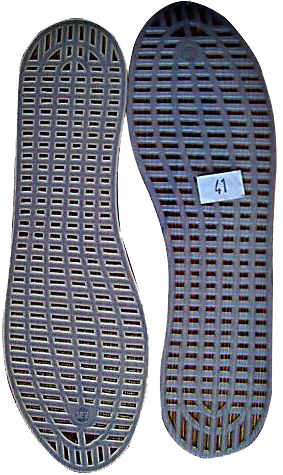

Today you can still find "opinacze" on sale, but they made no less than 20 years ago. By some opinions, the earlier versions of "opinacze" were the best by the quality of leather and overall workmanship (the robustness of the boots was enhanced with additional rivets). But the boots made since the late 1980s to the early 1990s are not as good in quality and they lack the metallic rivets due to economy reasons.
At first the production of brown "opinacze" was stopped, while black boots were still manufactured for some time. The highest in quality were those boots, the soles of which were marked as "OLEJOODPORNE, i.e. "oil-resistant".
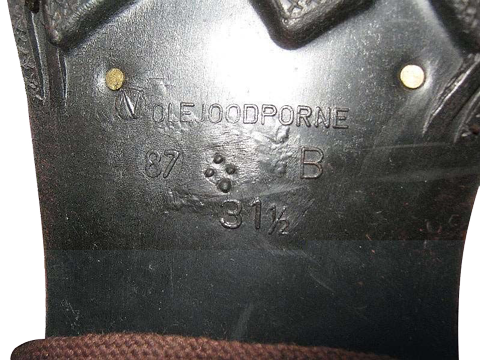
In addition to the use of these boots by the Polish Armed Forces, as well as the footwear for hikers, hunters, and even builders, the "opinacze" were widely used in the environment of the youth subcultures (metal-heads, punks, goths, skinheads ...) before the "real" stylish boots like "Grinders" and "Dr.. Martens" became available in Poland.
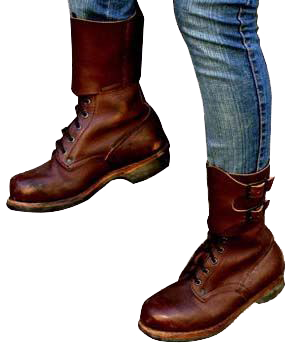
The robustness and reliability of the old Polish military boots ("opinacze") was glorified even in the Polish sergeant's joke, with which they met every group of young recruits:
"...stara sier żancką podpuchę unitarkową:
- Zołnierze! Każdy, który w czasie treningów marszowych rozwali buty, dostanie nowe z magazynu i zostanie zwolniony z wszystkich dalszych treningów.
Naiwne młode wojsko tupie zawzięcie o beton do upadu, a buty to wytrzymują. Ja przynajmniej nie słyszałem, by udało się komuś przetrzeć szwy podeszwowe, czy jakoś inaczej rozwalić buty maszerowaniem. Nasze buty wojskowe niszczy się wyłącznie brakiem natłuszczania!"
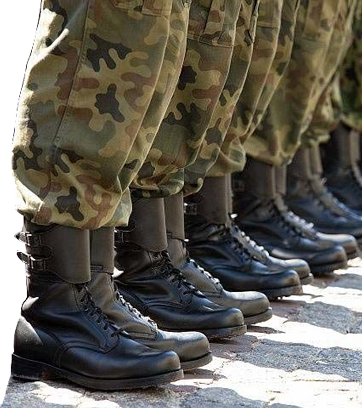
("The new recruits were said, that the one who manage to break his "opinacze" when marching will be issued a new pair of combat boots immediately, and will be further released from the marching drill. The naive young soldiers stomped till they fell tired, knocking their feet down on the concrete parade ground, but the boots, of course, survived such treatment. Over the years there were no cases, when someone managed to grind the weld on the out-sole or "break" the boots while marching. So these "opinacze" combat boots can go through any hardships, except for the absence of regular lubrication").
One should also mention the boots for ceremonial battalion (parade battalion) of the Polish Armed Forces (Opinacze w Batalionie Reprezentacyjnym WP). Since 1989, the soldiers of this unit are provided with a new kind of boots - the black boots of model 925/MON (wz 925/MON) with the out-soles, padded with 36 steel nails and with steel tips on the toes and the heels.
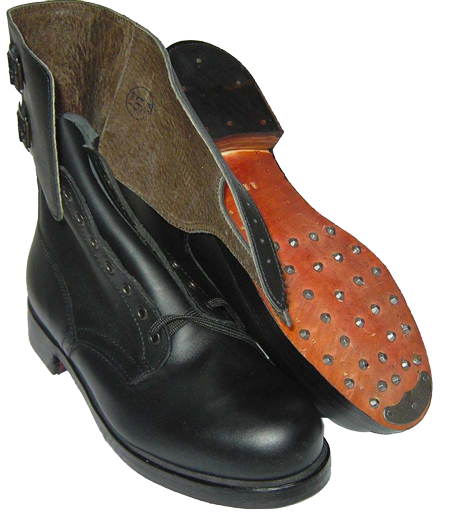
These boots are also very sturdy and reliable, and the out-soles with metal nails and tips make a distinctive sound during the marching steps. These boots are manufactured by "Protektor SA" company from Lublin.
Polish Army "Jump" Boots of Model 919/MON
The Polish army "jump" boots model 919/MON (aka "buty skoczka" or "skoczky" in Polish language) are issued to the country's Armed Forces since 1993.
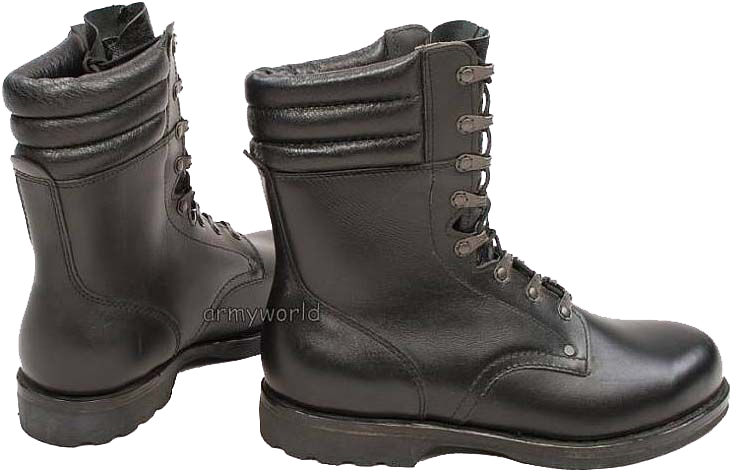
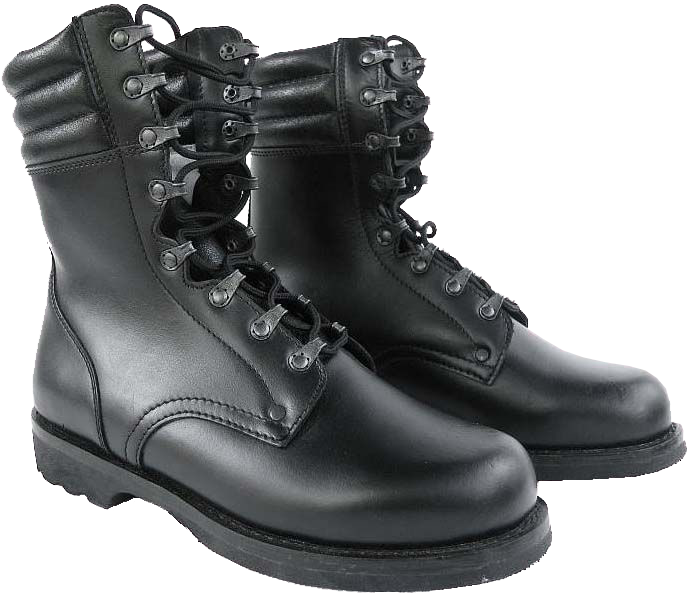
They differ in appearance from the classic Polish "opinacze" by the lack of cuff with two buckles and the presence of a soft cushion at the top of the boot, which is intended to prevent the ingress of water, dust and pebbles inside the boots. The very first test models of these boots were of dark cherry colour, but later the main colour became black. Initially 919/MON "jump" boots were developed specially for the Polish airborne troops, but later they were supplied to land forces as well. Currently, these "jump" boots are used as summer footwear.
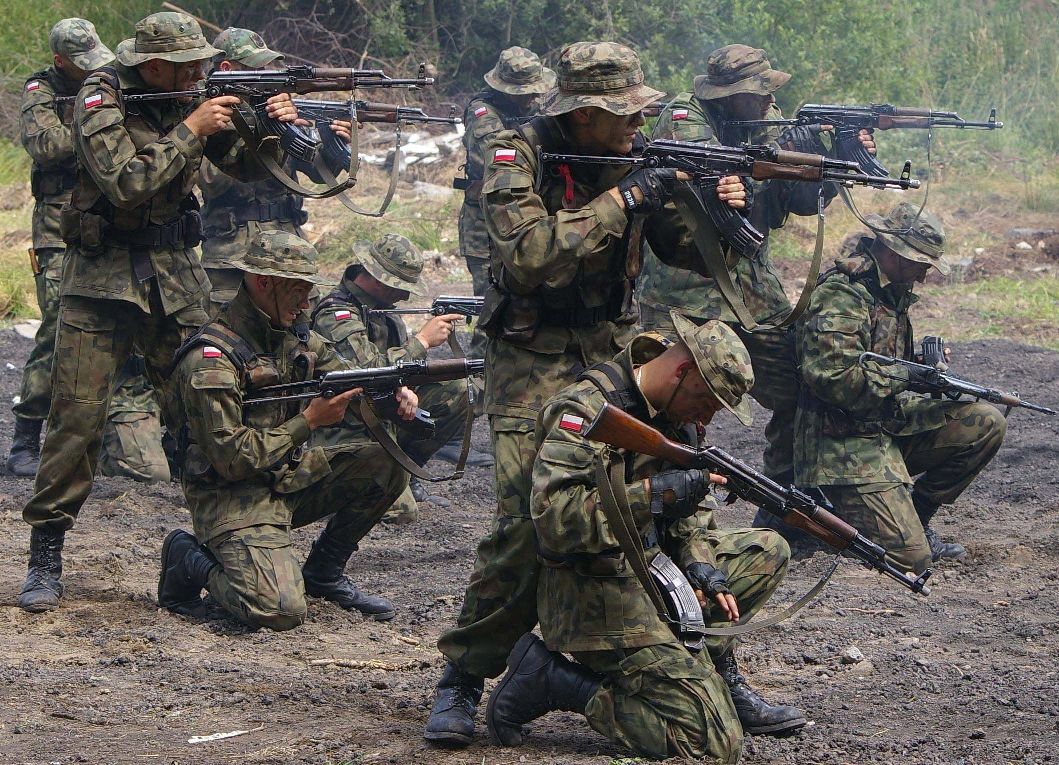
Almost immediately, these "jump" boots got the name "desantu", to distinguish them from "zajaców", i.e. "hares". The Polish paratroopers used this nick-name ("hares") to call the land soldiers, just in the same way as the American paratroopers used the term "straight-legs" to call their land-based companions.
Later it turned out that, despite the fact that the new boots were more lightweight and comfortable, the overall quality of raw materials, leather dyes and manufacture, the new boots were not as good as the old and time-proven "opinacze". It is difficult now to find out the exact backstory, but the new boots got a scornful nick-name "józefy".
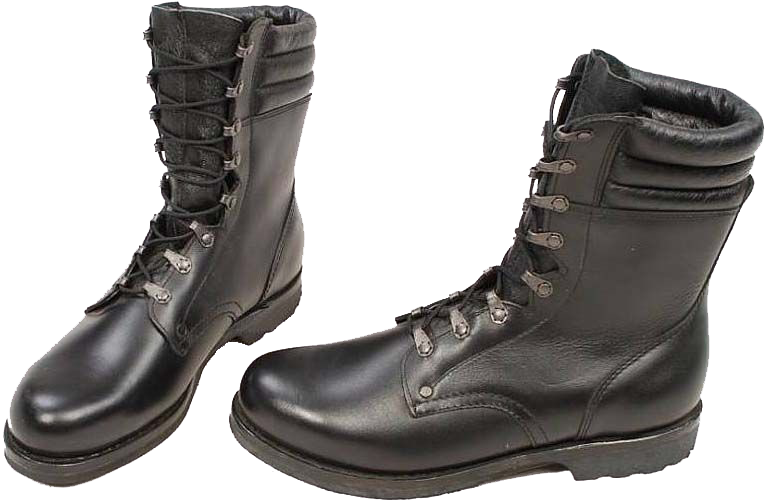
The refusal from such elements as the cuffs and buckles on the 919/MON "jump" boots was caused by purely practical considerations: the buckles always represented a potential threat of catching on the equipment details. They could prevent the normal opening of the parachute canopy as well.
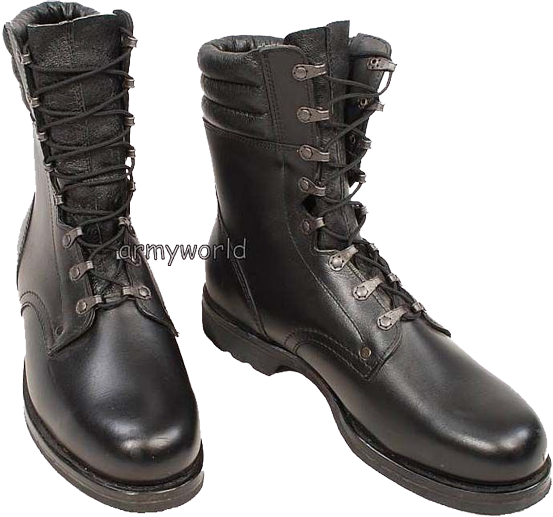
So the 919/MON "jump" boots now represent by themselves the high black-coloured boots, the upper part of which feature the quilted soft "collar" padding.
The top of these boots are made of natural cowhide leather with hydrophobic impregnation ("skóra naturalna bydleca wodoodporna" in Polish), the mid-sole is made of thick leather, it is glued and stitched to the vulcanized rubber protector (non-slip, resistant to abrasion and oil, gasoline and other solvents).
In contrast to the previous models, these boots do not have leather cuffs with buckles at the top, so the boots are fixed on the feet with lacing only. The quick-lacing system consists of eight pairs of eyelets, enabling quick putting the boots on and off.
919/MON "jump" boots feature thin grey-coloured lining of "glove-type" leather, which, in combination with soft stitched leather "collar" provides comfort of wear and protect the feet from possible injury and ingestion of water and small pebbles inside the boots.
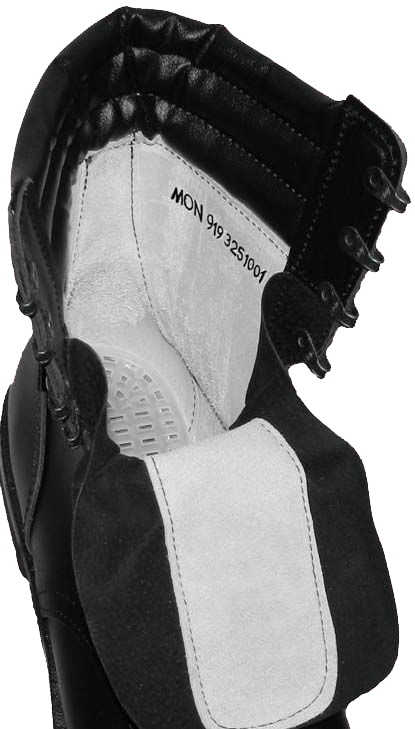
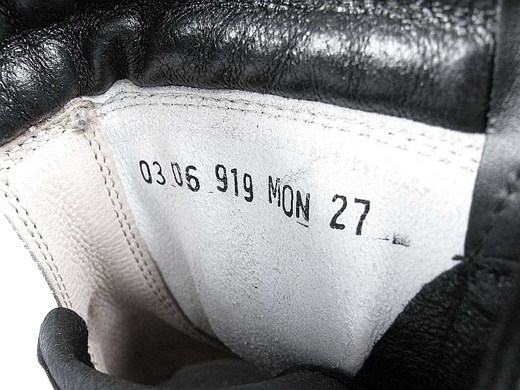
The initial version of the 919/MON "jump" boots was slightly different from the modern version boots: they were cherry-brown in colour and a few centimetres higher (their lacing system featured an additional pair of eyelets).
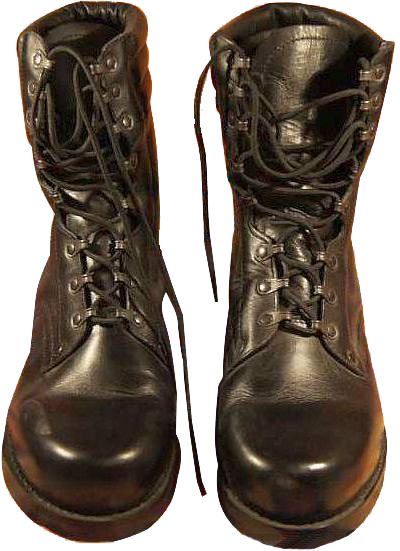
The Polish sources inform, that during the development of 919/MON "jump" boots it were the "Alte Art" ("Old style") Bundeswehr boots (prior to the Modell 2000 boots), which were used as an example to follow: "Wzorowane czę ściowo na starszych modelach trzewików Bundeswehry".
The flap of the boot's tongue is "semi-closed", i.e. not stitched to the top. The out-soles of the boots are made of hard vulcanized rubber, oil-and petrol-resistant. There are two types of the out-soles: classic "Vibram" and Polish-developed "Salute" type (typu "SALUT"): oil-, petrol-resistant and non-slip.
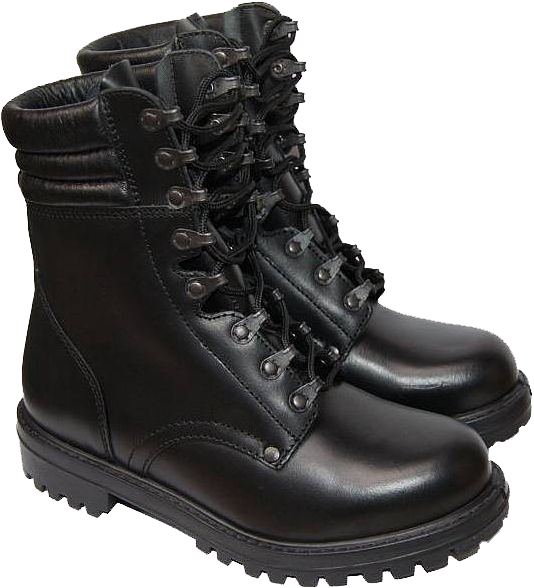

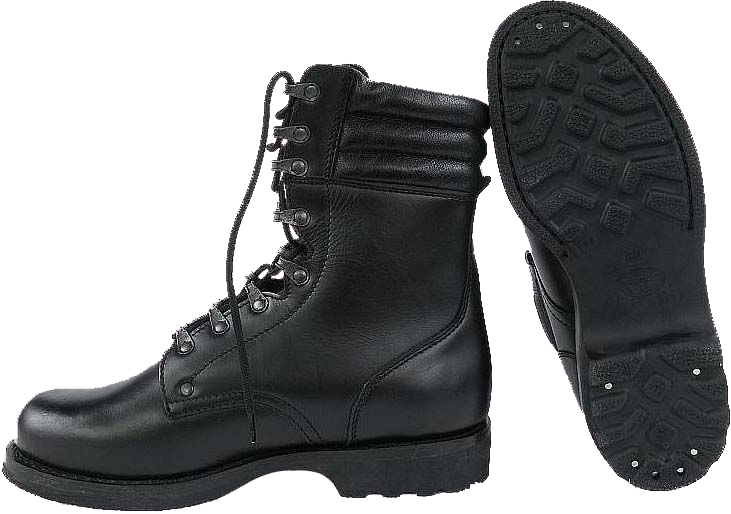
The winter version of the 919/MON boots also existed. In such boots the thin leather lining was replaced by natural or artificial fur, and the standard plastic mesh removable insole was replaced with leather and fur or simply felt.

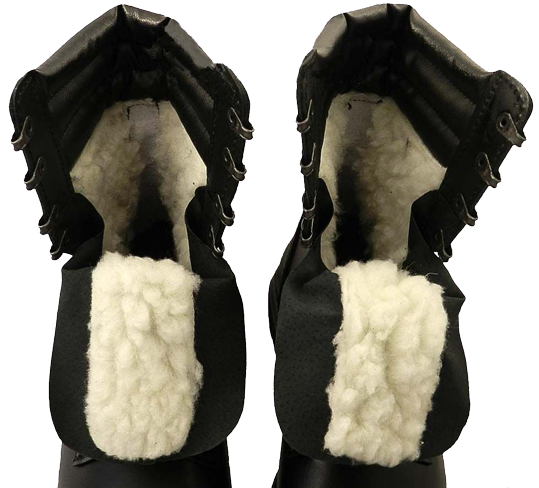
"Protektor SA" footwear company from Lublin is the main developer and manufacturer of the 919/MON model Polish army boots. The city and producer of certain pair of army boots are usually indicated on the boots out-soles.
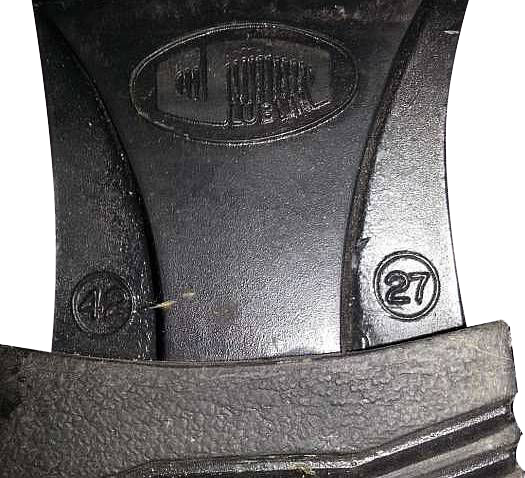
Among the other manufacturers of these boots one should name "Spóldzielnia Pracy Wyrobów Skórzanych im. Jana Kilińskiego" ("Cooperative for the production of leather goods, named after Jan Kilińsky", and the companies "Demar", "Wojas", "Gdynia" and "Armex", which use the out-soles, made by "Protektor SA" (the developer of these boots), or their own-designed out-soles.
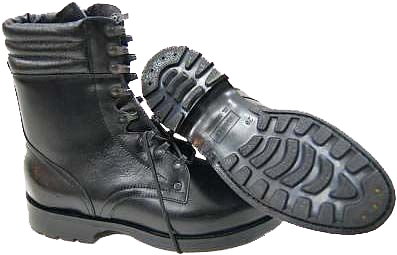

The cost of a pair of 919/MON boots in Poland is about 180 zlotyh (that is equal to 43 Euros).
"Szczury" ("Rats") - "Desert" Boots of Poland (Model WZ.920/P)

The development of military liaisons between Poland and NATO countries has become very intensive after 1989. Since then, the country, in the capital of which the Warsaw Pact was signed, has become one of the most active participants in almost all the military operations of the Western world.
Already on November 22, 1990 the Polish military contingent ("Polski Kontyngent Wojskowy w składzie Wielonarodowych Sił w rejonie Zatoki Perskiej") was formed as a part of the International Forces in the Persian Gulf, and took part in the war against Iraq in early 1991.
Since 1994, Poland cooperated with NATO in the framework of the "Partnership for Peace" program, and, finally, on March 12, 1999 Poland joined the NATO. In the same year the Polish soldiers actively participated in the operations in Kosovo and Metohija (KFOR), then they acted as a part of the UN Peacekeeping Forces in Southern Lebanon.
After the collapse of the Warsaw Pact, Poland became focused not so much on the countries of the so-called "old Europe" (Germany, France etc...), but on the United States and did everything to prove itself as "the most faithful of all the American allies". So the military contingent of Poland took active participation of in the American operations in Afghanistan (in March 2002) and in Iraq (from spring 2003).
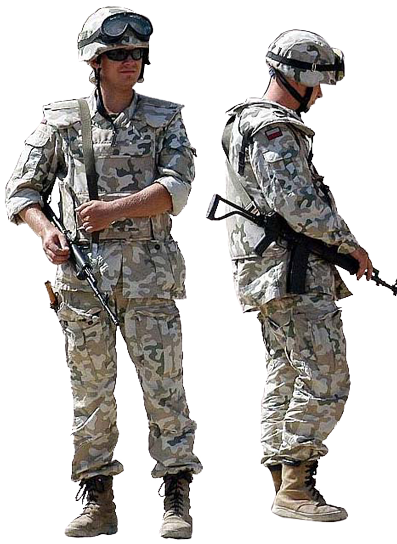
These wars have demanded the introduction of the appropriate clothing, footwear and equipment. The famous Polish "honour" (which sometimes "borders" with superciliousness) and traditionally high self-esteem didn't tolerate the idea of using the ready equipment of any other country, in contrast to such countries as Austria or the Netherlands, which easily allowed using pieces of foreign uniform and equipment during the overseas operations. So, in a short time Poland launched the production of own-developed and made "desert" uniforms and footwear.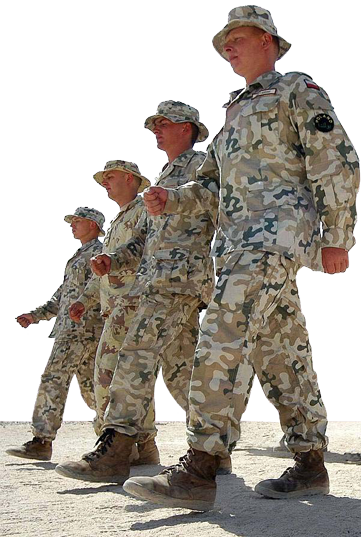
The Polish name for these boots: "Trzewiki ćwiczebne tropikalne wz.920/MON" (i.e. "Tropical training boots Model 920/MON"), or "Trzewiki Pustynne Wz.920P/MON" ("desert" boots Model 920/MON). MON (Ministerstwo Obrony Narodowej) is for Ministry of National Defense of Poland. In common practice these desert boots are often called "Szczury" (i.e. "Rats").
These "desert" boots are very lightweight: a pair of "Rats" boots weighs approximately as a single standard Polish army leather boot. For Polish size 26 a pair of such boots weights about 1400 grams, and by customer experience they are like sports shoes.
The very early Polish "desert" boots still retained some elements of black colour: the out-sole, the soft leather cushioning on top of the boots and even the laces. Originally the design of the boots top featured no excessive or complex elements, and even now the Polish "desert" boots are made just from several pieces of suede, the thickness of which is about 1.5 mm.
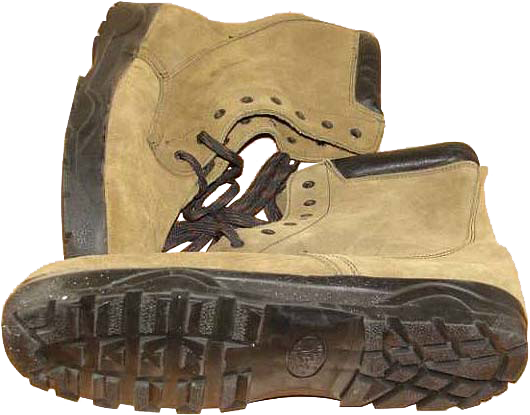

On the one hand, black colour is not needed for the "desert" boots in particular. On the other hand, in the desert conditions the boots very quickly become covered with dust and obtain almost uniform colour. Further on the design of the Polish "desert" boots was improved. The tongue of the boots is sewn quite high, almost to the top of the boots.
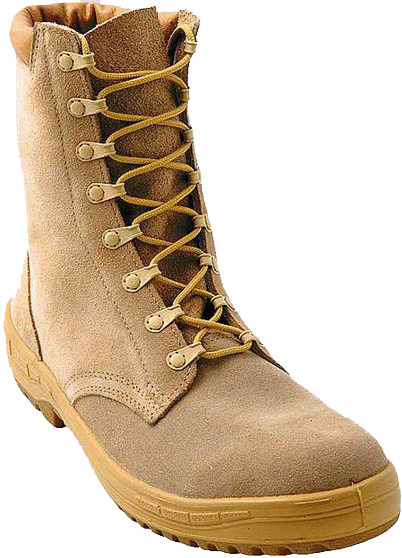
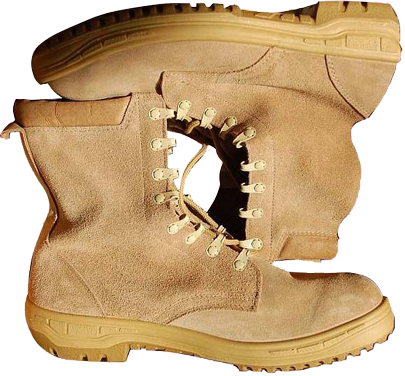
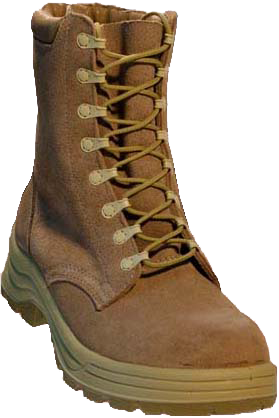
The Polish "desert" boots on the new model (plain sandy coloured), unlike the earlier version, already use speed-lacing system ("systema szybkiego sznurowania" in the Polish language), consisting of eight pairs of identical "MARK" eyelets instead of simple round eyelets. The length of the laces is approximately 1.9 m, for the largest and the smallest size boots the length may vary slightly.
Among the main manufacturers of the Polish "desert" boots are such companies as "Demar" (with production facilities in Nowy Targ city), and "Protektor SA" company of Lublin.
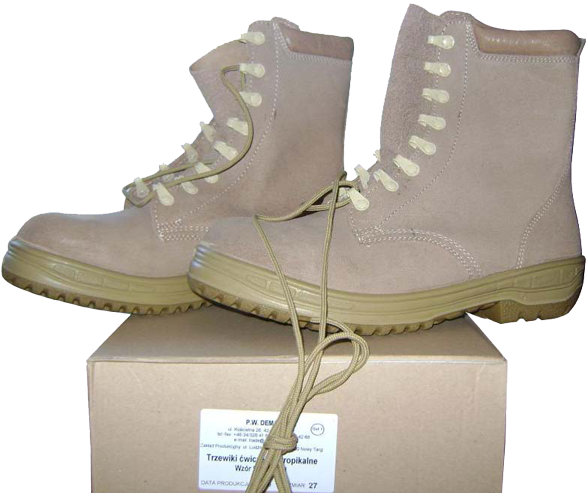
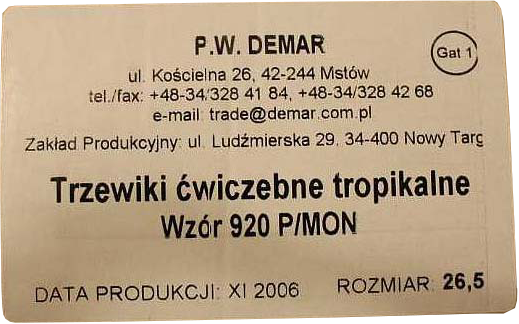
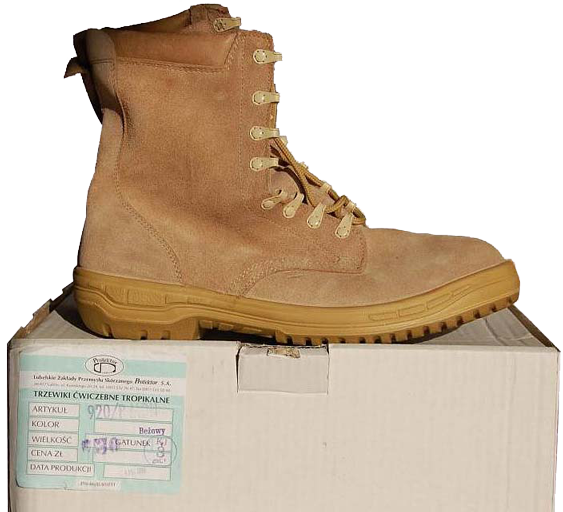
One can find the new model of the Polish "desert" boots, featuring the speed-lacing eyelets and the out-sole of old-style black colour. Perhaps, this could be due to the availability of "old stocks" of the out-soles and accessories, used for the production of black light tactical and police boots for the special forces unit "Grom" ("Thunder"), and the urgency of the "desert" boots order.
In contrast to the "desert" footwear of the US, Germany, UK, Denmark, the Netherlands and many other countries, the Polish "Szczury" ("Rats") boots use no textile material. The boot's top and the tongue of the boots are made of soft, durable and breathable nu-buck leather (calfleather). The Poles say that these boots get dirty pretty quickly, but it's easy enough to clean them with a brush. If the boots are not treated with some "AQUASTOP"-type spray, they become wet quite quickly, but dry quickly as well.
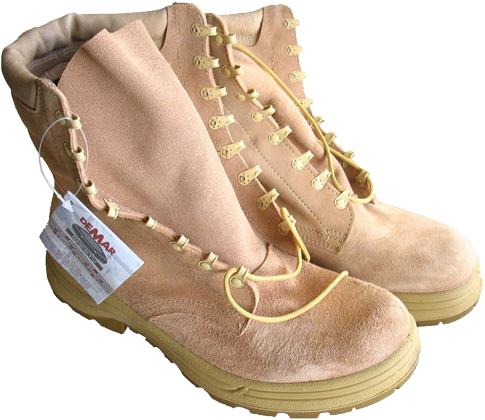

As one can see on the photo, the leather of the boot's top is smooth inside and nappy on the outside, and it even looks very soft. The top of the boots feature soft leather cushioning intended to prevent the ingress of sand, dust and small pebbles.
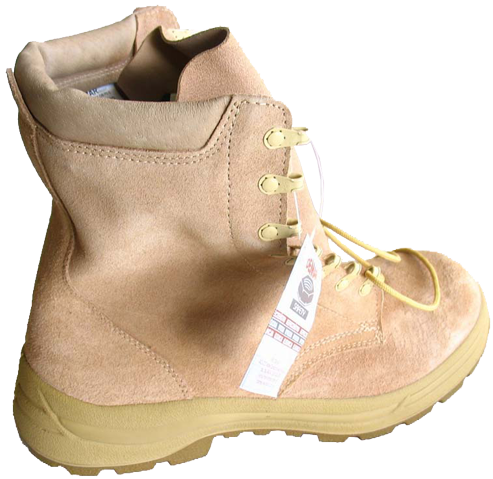
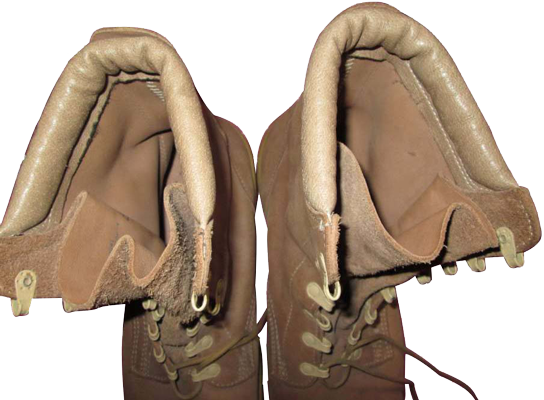
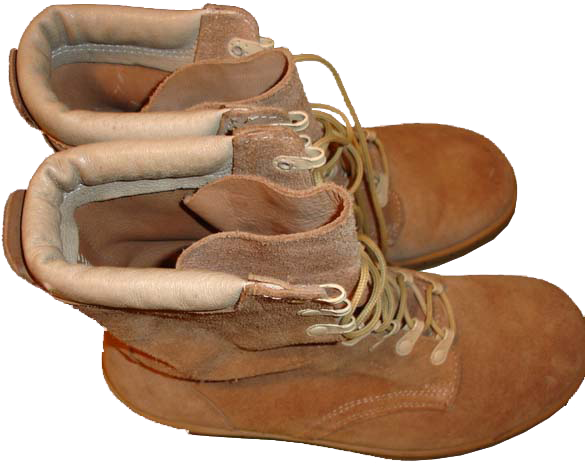
Since Polish "Szczury" ("Rats") boots, intended for hot and arid climate, are quite lightweight and thin, the fixation of ankle joints and protection against disjunction are rather weak. These boots are quite good for dry and cold weather too, if one takes one size bigger boots and put on an extra pair of wool socks - so do the Danes, and the two-layer out-sole with polyurethane foam inside provide good protection against freezing of the out-sole.
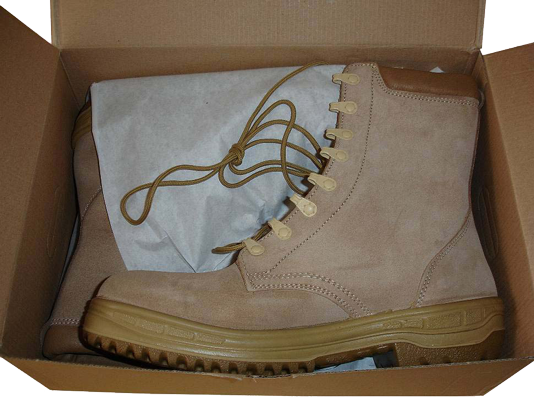
The top and out-sole have become almost the same in colour, i.e. sand-colour in different shades, depending on the manufacturer - some boots are almost brown in colour, others are more sandy-coloured, but the leather cushioning at the top of the boots is usually lighter or darker than the base colour of the boots top.
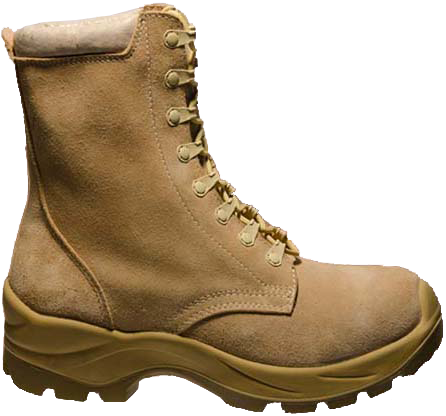
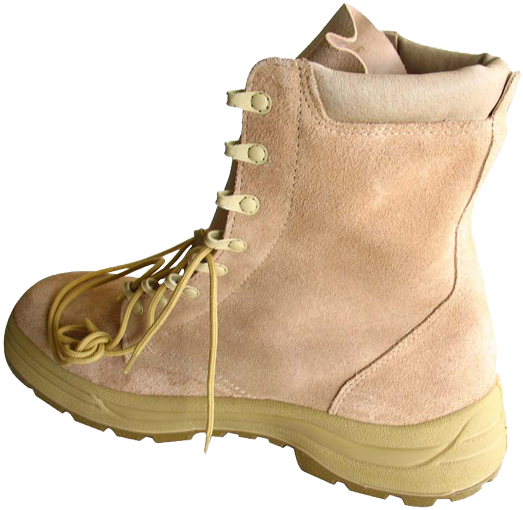

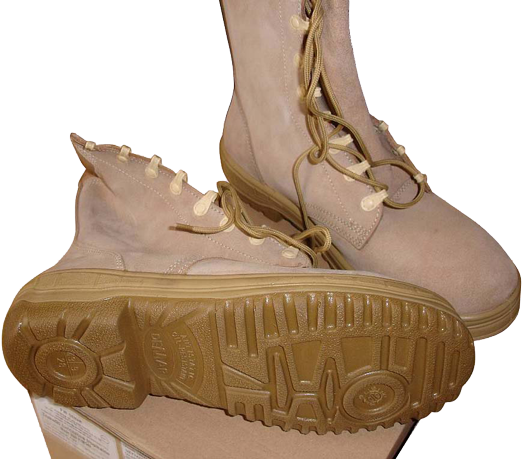
The out-soles of the Polish "Szczury" ("Rats") "desert" boots are very different. Initially, they used two-layers (polyurethane foam + durable heat-resistant rubber) out-sole of "Gepard" ("Cheetah") type ("dwuwarstwowa podeszwa z poliuretanu i gumy "Gepard"" in Polish language) for the early versions of new model boots. This type of out-sole is "round-shaped", streamlined, and almost completely the same as the ones used for the black light tactical and police boots "Grom" ("Thunder"), but of the sandy colour. Such type out-sole is quite soft and easily abraded on the city asphalt and other abrasive surfaces, at the same time it is very lightweight, flexible, and provides comfort, quiet pace and efficient adhesion with different types of surfaces. But on rough or rocky terrain all the bumps and stones are quite painful, and the protection of the feet from any sharp objects are also out of the question.

On the heels, in a round-shape element of the tread pattern, the dimensions are indicated: European size (size 40 in the photo shown), size in centimetres (26) and width of the boot (65). Such information may be indicated on the attached label or on just inside the boots, under a soft leather cushioning on the top of the boots. Such indication shows two-digit month and year of production (08 07 means August 2007), the model (920 P/MON, where p stands for "Pustynne" - "Desert") and the sizes.
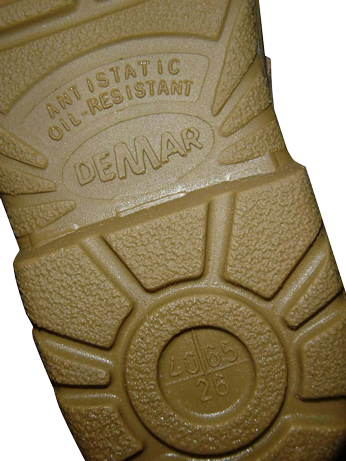
But "Gepard" ("Cheetah") is not the only type of the out-soles used. The same manufacturers produce boots of other models, colours and tread patterns. There is an example of the double-layer polyurethane out-sole of "ARM" type ("Podeszwa PU/PU typu "ARM").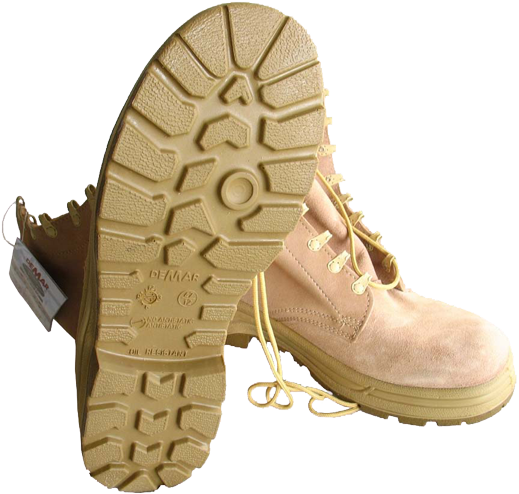
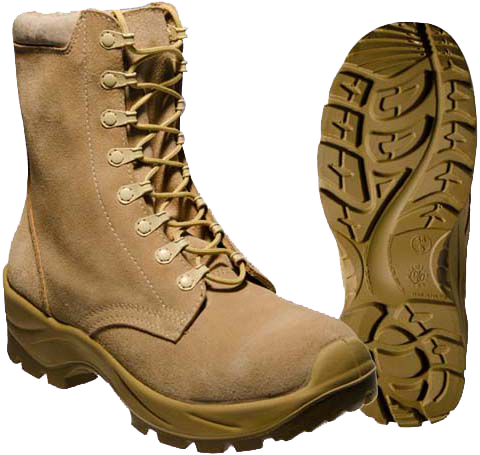
The table below shows the size chart of the Polish army "desert" boots manufacturers.

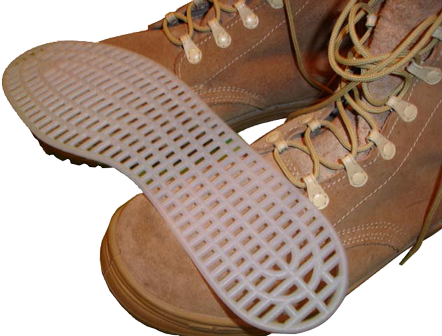
The out-sole is made of two-layer, composite rubber of various densities. This is a fairly common design - a layer of foamy polyurethane inside the main oil-petrol-resistant and resistant to high temperatures rubber out-soles. Virtually the same out-soles are used for the Danish "desert" boots produced by "LeBock" company). The out- soles are glued to the suede top, but the used glue is enough good in quality and there were no serious complaints on this matter.
We should also mention the insoles ("wkładki" in Polish). They come as standard army-issued plastic insoles ("wkładka plastikowa"), white-coloured with large cells (almost the same as in the Hungarian old model military boots) and as leather insoles ("wkładka skórzana"), almsot the same as in the Austrian military boots.

It is recommended to choose the size of the insoles (actually it's the inner size of the boots) approximately 1 mm larger than the actual size of one's feet, in order to provide ventilation and comfort of wear. The example of such ratios is given in the table.
| Boots size | 23 | 23,5 | 24,5 | 25 | 31 |
| The length of the insole in cm: | 23,5 | 24,5 | 25,5 | 25,8 | 32 |
The plastic insoles provide good ventilation, but, judging by the reviews of the Polish Army veterans on the thematic Polish forums, such insoles quickly tear and wear out the cotton socks, so it is recommended to use two socks at once: thin cotton sock underneath, and another, more durable synthetic fibre sock over it. Some users discard the standard rough plastic insoles and replace them with better and more anatomically correct privately-purchased insoles. But, in fact it is typical not only for Poland, but also for many other armies, particularly in Israeli Defence Forces.
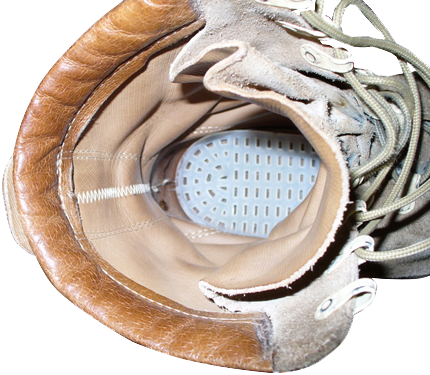
Exclusively for cartalana.com
We have much more interesting information on this site.
Click MENU to check it out!
∎ cartalana.com© 2009-2024 ∎ mailto: cartalana@cartalana.com